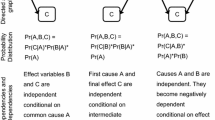Abstract
This paper investigates the relations between causality and propensity. Aparticular version of the propensity theory of probability is introduced, and it is argued that propensities in this sense are not causes. Some conclusions regarding propensities can, however, be inferred from causal statements, but these hold only under restrictive conditions which prevent cause being defined in terms of propensity. The notion of a Bayesian propensity network is introduced, and the relations between such networks and causal networks is investigated. It is argued that causal networks cannot be identified with Bayesian propensity networks, but that causal networks can be a valuable heuristic guide for the construction of Bayesian propensity networks.
Similar content being viewed by others
REFERENCES
Cartwright, N.: 1983, How the Laws of Physics Lie, Clarendon Press, Oxford.
Fetzer, J. H.: 1981, ‘Scientific Knowledge: Causation, Explanation, and Corroboration', Boston Studies in the Philosophy of Science, Vol. 69, Reidel, Dordrecht.
Gillies, D. A.: 1998, ‘Debates on Bayesianism and the Theory of Bayesian Networks', Theoria 64(1), 1–22.
Gillies, D. A.: 2000, ‘Varieties of Propensity', British Journal for the Philosophy of Science, 51, 807–835.
Humphreys, P.: 1985, ‘Why Propensities cannot be Probabilities', The Philosophical Review 94, 557–570.
Jensen, F. V.: 1996, An Introduction to Bayesian Networks, UCL Press, London, UK.
Kant, I.: 1787, Critique of Pure Reason, 2nd edn, English translation by Norman Kemp Smith, Macmillan (1958).
Kwoh, C.-K. and D. F. Gillies: 1996, ‘Using Hidden Nodes in Bayesian Networks', Articificial Intelligence 88, 1–38.
Lauritzen, S. L. and D. J. Spiegelhalter: 1988, ‘Local Computations with Probabilities on Graphical Structures and their Application to Expert Systems (with discussion)', Journal of the Royal Statistical Society B 50(2), 157–224.
Neapolitan, R. E.: 1990, Probabilistic Reasoning in Expert Systems, John Wiley.
Pearl, J.: 1986, ‘Fusion, Propagation and Structuring in Belief Networks', Artificial Intelligence 29, 241–288.
Pearl, J.: 1988, Probabilistic Reasoning in Intelligent Systems: Networks of Plausible Inference, Morgan Kaufmann, San Francisco.
Pearl, J.: 2000, Causality. Models, Reasoning, and Inference, Cambridge University Press.
Popper, K. R.: 1934, The Logic of Scientific Discovery, 6th revised impression of the 1959 English translation, Hutchinson (1972).
Popper, K. R.: 1957, ‘The Propensity Interpretation of the Calculus of Probability, and the Quantum Theory', in S. Körner (ed.), Observation and Interpretation, Proceedings of the Ninth Symposium of the Colston Research Society, University of Bristol, Butterworths Scientific Publications, pp. 65–70 & 88-89.
Popper, K. R.: 1959, ‘The Propensity Interpretation of Probability', British Journal for the Philosophy of Science 10, 25–42.
Popper, K. R.: 1990, A World of Propensities, Thoemmes.
Reichenbach, H.: 1956, The Direction of Time, University of California Press, Berkeley, CA.
Salmon, W. C.: 1971, ‘Statistical Explanation', in W. C. Salmon (ed.), Statistical Explanation and Statistical Relevance, University of Pittsburgh Press, Pittsburgh, PA.
Salmon, W. C.: 1978, ‘Why Ask, “Why?”? An Inquiry Concerning Scientific Explanation', in Salmon (1998), Ch. 8, pp. 125–141.
Salmon, W. C.: 1979, ‘Propensities: A Discussion Review', Erkenntnis 14, 183–216.
Salmon, W. C.: 1980, ‘Probabilistic Causality', in Salmon (1998), Ch. 14, pp. 208–232.
Salmon, W. C.: 1998, Causality and Explanation, Oxford University Press.
Sucar, L. E., D. F. Gillies, and D. A. Gillies: 1993, ‘Objective Probabilities in Expert Systems', Artificial Intelligence 61, 187–203.
Suppes, P.: 1970, A Probabilistic Theory of Causality, North-Holland, Amsterdam.
Williamson, J.: 1999, ‘Does a Cause Increase the Probability of its Effects?’, philosophy.aireport pai_jw_99_d, http://www.kcl.ac.uk/philosophy.ai.
Williamson, J.: 2001, ‘Foundations for Bayesian Networks', in D. Corfield and J. Williamson (eds.), Foundations or Bayesianism, Kluwer, pp. 75–115.
Author information
Authors and Affiliations
Rights and permissions
About this article
Cite this article
Gillies, D. Causality, Propensity, and Bayesian Networks. Synthese 132, 63–88 (2002). https://doi.org/10.1023/A:1019618817314
Issue Date:
DOI: https://doi.org/10.1023/A:1019618817314




